Source: The Conversation (Au and NZ) – By Chris Honig, Lecturer, The University of Melbourne
Review: RONE in Geelong, Geelong Gallery
In 2004, black-and-white posters of a woman staring into a distant horizon began appearing inexplicably throughout Melbourne. The images — of model Suzanne Brenchley, taken from a fashion magazine ad — were renamed Jane Doe by street artist Rone, who had created them. To avoid criminal prosecution, his paste-ups were applied surreptitiously at night.
These works contributed to the patchwork assemblage of stickers, tags and stencils that formed Melbourne’s burgeoning street art scene at the time. Although it is synonymous with Melbourne’s inner-city cultural identity today, this was a time before Banksy’s meteoric ascendancy, so municipal authorities made no distinction between unauthorised street art and vandalism.
Most of these early works were erased in 2006 in an attempt to beautify Melbourne for the Commonwealth Games.
Following Banksy, street art was propelled from its counter-cultural origins into the mainstream and Rone’s career trajectory followed this cultural arc. He has since painted one of Melbourne’s art trams and murals of Kylie Minogue and Cate Blanchett for the NGV’s Jean Paul Gaultier exhibition. Rone himself has advertised clothing for Uniqlo.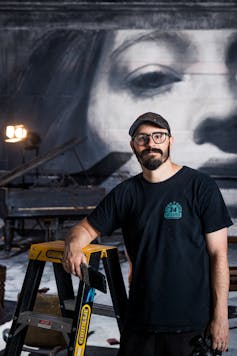
Last month, to underscore this inversion from subculture to peak mainstream, Rone was awarded a $1.86 million RISE Arts grant from the federal government. It was met with surprise: grants of this size usually go to theatre companies or production houses, rather than individual artists (although Rone will employ other practitioners as part of it).
Rone’s latest exhibition at Geelong Gallery in his home city is a comprehensive survey of his work over two decades, tracing the evolution of his Jane Doe motif into states of greater realism, painterly technical proficiency and larger scale murals.
It is styled in decaying vintage opulence, like an ethereal moment in time. There are murals painted directly onto the walls of the gallery but the majority of the exhibition features studio works on varied surfaces, under framed glass: early stencils on canvas, portraits on poster advertising (styled to look torn and weathered) and poster-sized photographs of murals in abandoned, dilapidated buildings.
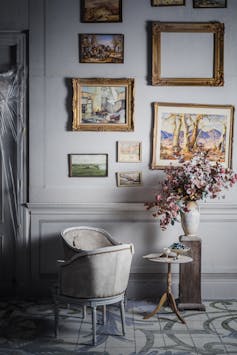
All street art is ephemeral, but here Rone exaggerates transience in the staging and framing of the work. The smooth porcelain skin of Rone’s “muses” juxtaposed against flaking, crumbling walls provides an arresting contrast of textures. The rooms are styled by Carly Spooner, mixing decadence and disintegration.
The exhibition is accompanied by a musical score by composer Nick Batterham. Highly evocative, the classical arrangement enhances a haunting atmosphere and sense of loss; the music was originally written in response to the 2019-20 Black Summer bushfires.
Read more: Latest arts windfalls show money isn’t enough. We need transparency
Empty show
Before Banksy’s success, it was difficult for street artists to exhibit in established galleries. This led to the innovation of the “Empty Show”: street artists would install their works in an abandoned space and then hold unauthorised exhibition openings.
Rone has previously exhibited in non-traditional spaces: the derelict Lyric Theatre in Fitzroy (for Empty Project) and at Burnham Beeches, a dilapidated Art Deco mansion (for Empire). The art functions as an invitation to explore these spaces, which would otherwise be accessible only to trespassers.
It stimulates an imagined history of the buildings and invites speculation about the previous occupants. The spaces also fit with Rone’s apparent intention to use environmental decay as a material resource in his work.
The white cube of a gallery, however, is designed to remove everything else from view, leaving only the artwork for consideration. It’s perfectly climate-controlled to preserve the artworks inside.
So, in Rone’s latest exhibition, the themes of moribundity, transience and imagined historical echoes sit awkwardly in a traditional gallery space: broken bricks and detritus laid out carefully and precisely to mimic an abandoned building; a temporary artifice wall made with crumbled plaster. Translating his work into an art gallery has faded some of the verisimilitude (or the story world’s appearance of truth) and charm of previous exhibitions.
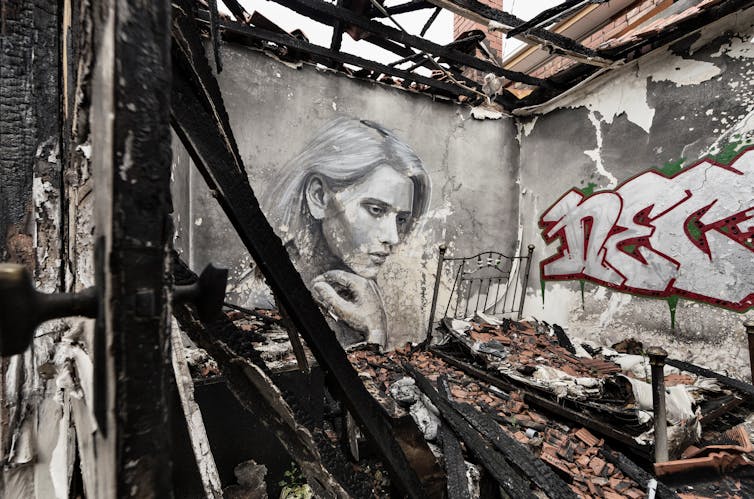
Read more: Getting to the (street) art of a year like no other
Pretty girls
The accompanying exhibition literature outlines the intended reading of the works: “beauty and decay”. But this immediately prompts a counter-reading: What is being presented as “beautiful”? What assumptions are encoded into the visual representation?
Many of the paintings conflate beauty with specific attributes: youth, Caucasian in appearance, female, thin-bodied, full-lipped, big-eyed. With few exceptions, there’s a very specific and narrow type of woman on display: the pretty girl motif via the male gaze. This motif can be found throughout popular culture: advertising, fashion and cosmetics, social media, pornography and the industry of celebrity.
Rather than trying to find beauty in new ways; these works are reproducing the most conventional notions of beauty to an established formula.
That doesn’t make the work necessarily “bad” (although some could argue it’s pernicious), but it does make the images derivative (of this mainstream motif).
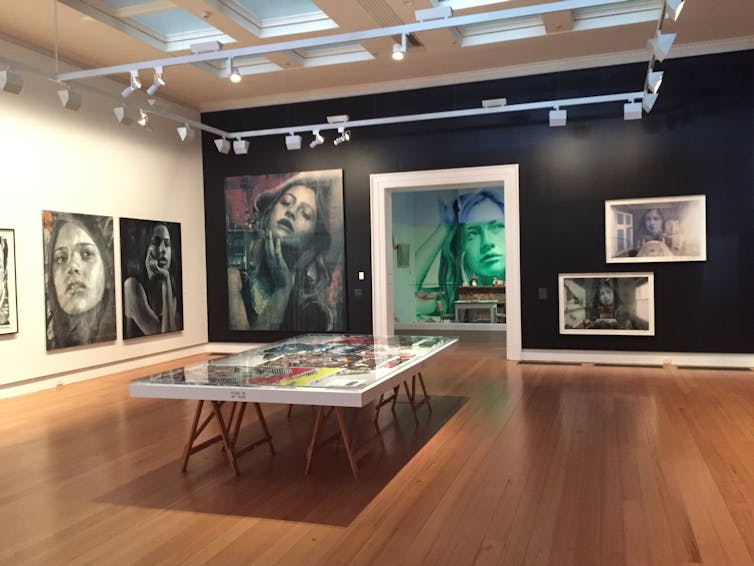
Read more: #GallerySoWhite: a digital exhibition exposing racism in contemporary art spaces
Divergent agendas
In the exhibition press release, the mayor of Geelong, Martin Cutter, is quoted as saying:
This exclusive Geelong Gallery exhibition is expected to attract over 25,000 people to the region and contribute approximately $3 million to the local economy.
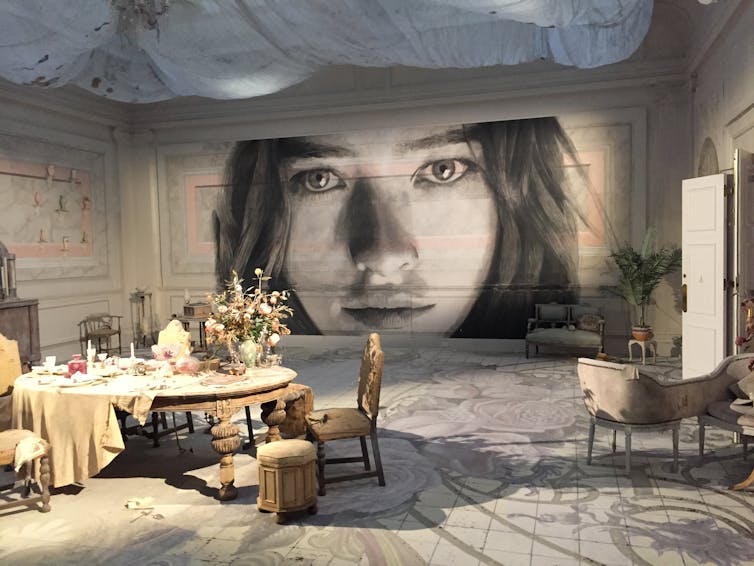
His high hopes for the show are well-placed. Deputy gallery director Penny Whitehead explained at the launch the exhibition has pre-sold 5,000 tickets, over three times the pre-sales of the touring Archibald Prize at the gallery.
Rone’s use of a proven formula (some would say cliché) is what makes it a favoured project for a risk-averse municipal body, hoping to revitalise a local tourism economy. The motif is familiar to a broad audience. No one feels challenged or lost. It will attract a large crowd.
This prompts an interesting discussion about the balance major public galleries must strike between populism and fostering new art that can be difficult or unfamiliar by virtue of its originality.
Attracting broader audiences is of course good, providing it’s not training them to engage only in superficial experiences. So if you attend the Rone Exhibition, the Geelong Gallery also has an impressive permanent collection of Australian art worth exploring. There are major works by Arthur Streeton and Frederick McCubbin, but I got lost in Charles Blackman’s painting of Joy Hester’s house .
RONE in Geelong, is at Geelong Gallery to 16 May.
– ref. Street art in a white cube: Rone at Geelong Gallery marries ephemeral beauty with a proven formula – https://theconversation.com/street-art-in-a-white-cube-rone-at-geelong-gallery-marries-ephemeral-beauty-with-a-proven-formula-155365







